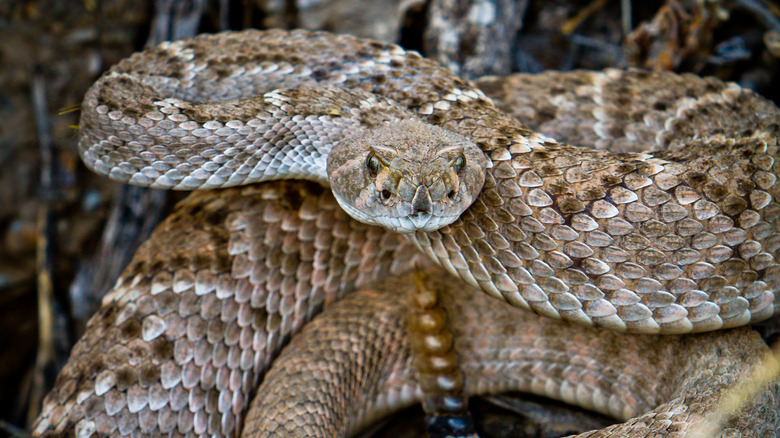An Expert Breaks Down The Most Dangerous Snakes In North America
Jay Brewer, founder of The Reptile Zoo and host of "Reptile Royalty," spoke exclusively to Outdoor Guide about the most dangerous snakes in North America. Brewer detailed that the continent is home to several highly venomous snakes that pose significant risks. "We've got eastern diamondbacks, we've got western diamondbacks, we've got Southern Pacific diamondbacks, we've got red diamondbacks," Brewer listed. He highlighted the Mojave green rattlesnake as particularly dangerous due to its venom composition.
Brewer pointed out that many of North America's venomous snakes share a distinct physical trait that helps in their identification. "The good part about North America is all our venomous snakes (except the bright-colored one that looks like a king snake) basically [have] a big kind of diamond head," he explained. This feature is especially prominent in rattlesnakes. "Those rattlesnakes all have kind of a heavy head, a kind of thinner neck, [while with] other snakes there's the head and the neck goes kind of connected," Brewer said, contrasting them with non-venomous snakes, which generally have a more uniform head and neck structure.
"Rattlesnakes ... come with a built-in alarm system," Brewer noted. If they feel threatened, they will rattle to alert you of their presence. There are other ways to recognize venomous snakes too, such as their eyes, color and, like Brewer explained about triangular heads, their shape.
The risks associated with North America's venomous snakes
North America's venomous snakes, such as the eastern and western diamondbacks and the Mojave green rattlesnake, are notorious for their potent venom. Brewer emphasized that these snakes can be extremely dangerous due to their venom's effects. "The Mojave Green ... has both neurotoxin and hemotoxins", he explained, highlighting the severity of their venom's impact on the human body.
Brewer also discussed how most venomous snake bites occur: "The majority of our bites in the United States are from people trying to kill it with a shovel, trying to mess with it." He stressed that most incidents result from individuals inadvertently disturbing or provoking the snake. To avoid bites, Brewer recommends not trying to handle or kill the snake, noting, "[A] rattlesnake wants way less to do with you than you want to do with it."
Environmental factors, such as long grass and rocks can also influence the likelihood of encountering these dangerous snakes. Maintaining a well-managed yard can help reduce the risk of attracting these reptiles to your lawn, for example, and educating yourself about which snakes are most dangerous is also important when staying safe.
Practical advice for dealing with venomous snakes
When encountering a venomous snake, Brewer advises maintaining composure and avoiding sudden movements. "You do nothing. That's the best thing," Brewer said, emphasizing that remaining calm is crucial. If you come across a rattlesnake, Brewer recommends stepping back slowly and giving the snake plenty of space. "The funny part about rattlesnakes is they'll sit really still if they think that they're detected," he noted. If they believe you have seen them, they will often remain still and then quickly move away once they feel safe.
Brewer also explained that if a rattlesnake senses danger, it may freeze in place, relying on its camouflage. "In the wild, things that don't move are branches ... and trees and rocks and things," Brewer said. This behavior allows the snake to blend in with its surroundings and avoid detection. "If you ever encounter one and you walk away and you look back, you'll all of a sudden see it's gone," Brewer added, highlighting how rattlesnakes prefer to avoid confrontation.
Overall, Brewer advises that understanding and respecting these reptiles can greatly reduce the risk of dangerous encounters. By recognizing their warning signs and avoiding actions that provoke them, you can ensure safer interactions with these fascinating creatures. To learn more about reptiles from Jay Brewer and his team, watch Season 2 of "Reptile Royalty," now streaming on The Roku Channel.


